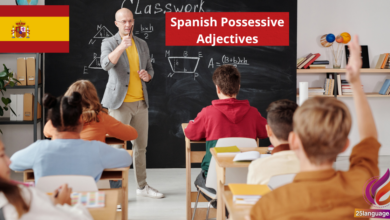How to Use the Future Perfect

Imagine being able to confidently express actions that will have been completed in the future—like saying, “By next year, I will have mastered spanish!” In today’s lesson on the Future Perfect (Futuro Perfecto), you’ll learn how to articulate these forward-looking thoughts. We’ll unravel the easy structure and usage of this tense, empowering you to discuss your plans and achievements with clarity and precision. let’s dive in and unlock the future together!
Mastering the future Perfect tense: A Comprehensive Guide
The future perfect tense in Spanish, known as “futuro perfecto,” expresses actions that will have been completed by a certain point in the future. To form this tense, you need to use the future tense of the auxiliary verb “haber” followed by the past participle of the main verb. The conjugation of “haber” in the future tense is as follows:
- yo habré (I will have)
- tú habrás (you will have)
- él/ella/usted habrá (he/she/you formal will have)
- nosotros/nosotras habremos (we will have)
- vosotros/vosotras habréis (you all will have)
- ellos/ellas/ustedes habrán (thay/you all formal will have)
Next, add the past participle of the action verb, which usually ends in -ado for -ar verbs and -ido for -er and -ir verbs. For exmaple, “haber comido” (to have eaten) or “haber hablado” (to have spoken). Together, they form sentences like “Para cuando llegues, yo habré terminado el proyecto” (By the time you arrive, I will have finished the project) and “Para el próximo año, habremos viajado a europa” (By next year, we will have traveled to Europe).
| Spanish Example | English Translation |
|---|---|
| Para 2025, habré completado mis estudios. | By 2025, I will have completed my studies. |
| Ellos habrán llegado antes de la cena. | They will have arrived before dinner. |
| Nosotras habremos visto esa película para el fin de semana. | We will have seen that movie by the weekend. |
Exploring the Structure and Usage of the future Perfect
the Future Perfect tense in Spanish, known as futuro perfecto, is used to describe actions that will have been completed by a specific point in the future. To form this tense,you use the future tense of the auxiliary verb haber combined with the past participle of the main verb. The structure is as follows: habré (I will have) + past participle. the conjugation of haber in the future tense is: habré, habrás, habrá, habremos, habréis, habrán.Such as: para el año 2025, habré terminado mis estudios. (By the year 2025, I will have finished my studies.)
It’s important to recognize when the Future Perfect is used, especially in relation to timeframes or expectations. Typically, this tense is employed in clauses that include future markers such as para cuando (by the time) or dentro de (within). Here are some critical points to remember:
- Use para cuando to indicate a deadline: Para cuando llegues, habré cocinado la cena. (By the time you arrive,I will have cooked dinner.)
- Express expectations with dentro de: Dentro de un año, habremos comprado una casa. (Within a year, we will have bought a house.)
- To form questions, invert the subject and auxiliary: ¿Habrás terminado el proyecto a tiempo? (Will you have finished the project on time?)
| Spanish Example | English Translation |
|---|---|
| Para el martes, habré leído el libro. | By Tuesday, I will have read the book. |
| Dentro de dos semanas, habré viajado a España. | Within two weeks,I will have traveled to Spain. |
| ¿Habrás aprendido el vocabulario para la prueba? | Will you have learned the vocabulary for the test? |
Practical Applications of the Future Perfect for Everyday Communication
The Future Perfect tense in Spanish, known as “futuro perfecto,” is utilized to express actions that will have been completed by a specific point in the future. To form this tense, you need to use the future tense of the auxiliary verb “haber” along with the past participle of the main verb. The structure is as follows:
- Future tense of “haber”: habré, habrás, habrá, habremos, habréis, habrán
- Past participle of the main verb (for regular verbs: -ar verbs end in -ado, -er/-ir verbs end in -ido)
Such as:
- Habré terminado mi tarea para mañana. (I will have finished my homework by tomorrow.)
- Habrás comido antes de llegar. (You will have eaten before arriving.)
| Spanish Example | english Translation | Grammar Rule |
|---|---|---|
| Habremos viajado a tres países. | we will have traveled to three countries. | Use ‘haber’ + past participle to indicate future completed action. |
| ¿Habrá llegado Juan a la fiesta? | Will Juan have arrived at the party? | Use for questions about future completions. |
| Habremos terminado el proyecto para el viernes. | We will have finished the project by Friday. | Indicates a deadline for future actions. |
Tips and Techniques for Mastering Future Perfect Constructions
The future perfect tense in Spanish, known as “futuro perfecto,” is used to express actions that will have been completed by a certain point in the future. To construct this tense, you need the future tense of the auxiliary verb “haber” followed by the past participle of the main verb. The conjugation of “haber” in the future is as follows:
- Yo habré (I will have)
- Tú habrás (You will have)
- Él/Ella/Usted habrá (He/She/You formal will have)
- Nosotros/Nosotras habremos (we will have)
- Vosotros/Vosotras habréis (you all will have)
- Ellos/Ellas/ustedes habrán (They/You all formal will have)
After the correct form of “haber,” insert the past participle of the main verb, which typically ends in -ado for -ar verbs and -ido for -er and -ir verbs. For instance:
| Spanish Example | Rule | English Translation |
|---|---|---|
| Yo habré terminado el trabajo. | Future perfect of “terminar.” | I will have finished the work. |
| Tú habrás comido antes de salir. | Future perfect of “comer.” | You will have eaten before leaving. |
| Ellos habrán llegado a las cinco. | Future perfect of “llegar.” | They will have arrived by five o’clock. |
Final Thoughts
hoy hemos explorado el futuro perfecto (futuro perfecto) en español, una herramienta poderosa que te ayudará a expresar acciones que se completarán en el futuro antes de otro punto en el tiempo. Recuerda que se forma con el verbo auxiliar “haber” en futuro simple, seguido del participio pasado del verbo principal. Por ejemplo,“habré comido” o “habrán viajado”.Hemos visto su uso en diferentes contextos y cómo puede enriquecer tu comunicación,permitiéndote hablar con más precisión sobre planes y expectativas. La práctica constante es clave; por ello, te animo a que incorpores el futuro perfecto en tus conversaciones diarias y escritos. Experimenta con crear oraciones sobre tus metas y aspiraciones: “Para el año que viene, habré terminado mis estudios.”
No dudes en repasar los ejemplos y ejercicios que hemos discutido hoy, y recuerda que cada esfuerzo cuenta en tu viaje de aprendizaje del español. ¡Sigue practicando y verás cómo tu confianza y fluidez mejoran día a día! ¡Ánimo y hasta la próxima lección!





























